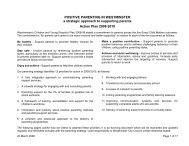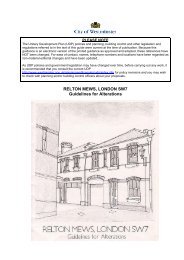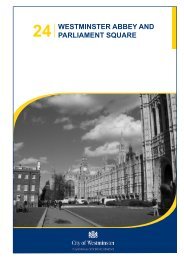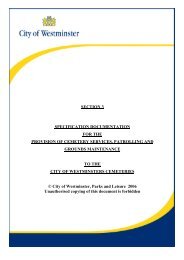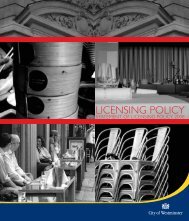Westminster Open Spaces Noise Study 2008 Final Report
Westminster Open Spaces Noise Study 2008 Final Report
Westminster Open Spaces Noise Study 2008 Final Report
- No tags were found...
You also want an ePaper? Increase the reach of your titles
YUMPU automatically turns print PDFs into web optimized ePapers that Google loves.
<strong>Westminster</strong> <strong>Open</strong> <strong>Spaces</strong> <strong>Noise</strong><strong>Study</strong> <strong>2008</strong>: <strong>Final</strong> <strong>Report</strong>relatively easy to understand link with sound level. In a rural context, tranquillity means therelative absence of man made sound, and the presence of a range of nature relatedsounds. An extensive study by the Campaign for Protection of Rural England (CPRE) 2 onareas of relative tranquillity focuses on the elements that make up the rural soundscape,and their value in terms of a tranquil experience.1.3 Pillars of urban tranquillity – a hypothesis1.3.1 For the purpose of this study, four possible ‘pillars of urban tranquillity’ were identifiedbased on studies by the Commission for Architecture and the Built Environment (CABE) onurban public space, Scott Wilson’s experience of studying urban space usage, as well asthe CPRE study on areas of rural tranquillity. This hypothesis was then tested againstthe findings of the attitudinal surveys, which went on to inform site assessments.The ‘four pillars of urban tranquillity’ that form this hypothesis are as below:1.3.2 Sounds – it is hypothesised that urban tranquillity is related to the different sound sets aspace may encompass, including natural as well as man made sounds. Relative quiet is afactor, as is the relative absence or low levels of certain types of urban noise (construction,workplace or traffic sounds). The masking of individual unfavourable sounds by a suitableneutral sound can add to a feeling of tranquillity. In <strong>Westminster</strong>, background noise is oftentoo high to distinguish any individual elements that in a rural context may be importantfactors of tranquillity, such as birdsong or crickets. Therefore, in an urban context, it isimportant to study soundscape from a perspective where relative levels and combinationsof sound can be appraised.1.3.3 Presence of nature – the sight, touch and smell of natural elements such as trees, wateror wildlife are especially valuable in urban contexts as a break from the order of the manmadeworld. Consolidated open spaces with little or no buildings are rare instances indense urban environments, and in the users mind are associated with tranquillity.1.3.4 Sense of personal safety – freedom from crime or threat to the person is a valid factor inthe experience of tranquillity. These have a sizeable effect on the ability to enjoy or evenexperience a space in a relaxed manner. Along with actual crime rates, it is important for aspace to be perceived as having a ‘safe’ image. A feeling of safety is linked in many users’minds to a wide range of factors including the number and dynamic of people within viewand earshot, and the presence of wardens or Park Police for example.1.3.5 Culture and freedom of the place – tranquillity in dense and urban environments is linkedto an overall ‘sense of place’, which involves many tangible and intangible variables suchas the history or context of the space, its design, the pace and range of activities possibleand how much an individual user is allowed to feel ownership and a sense of freedom inthe space. These indicators are a result of factors as diverse as the number and type ofseats, whether the space provides a taste of remoteness and the nature and frequency ofevents held here. These can all influence the way users interact with each other in aspecific space. Do users make eye contact and acknowledge each other on the one handbut respect each others’ privacy on the other? Layout can also have a strong bearing onculture, particularly whether the amount of space and circulation layout give people achoice of whether to be seen or not seen by other users, depending on mood and needs.1.3.6 A glossary of terminology relevant to this report is included as Appendix A.D121316/R1/022Scott Wilson LtdMarch 2009





